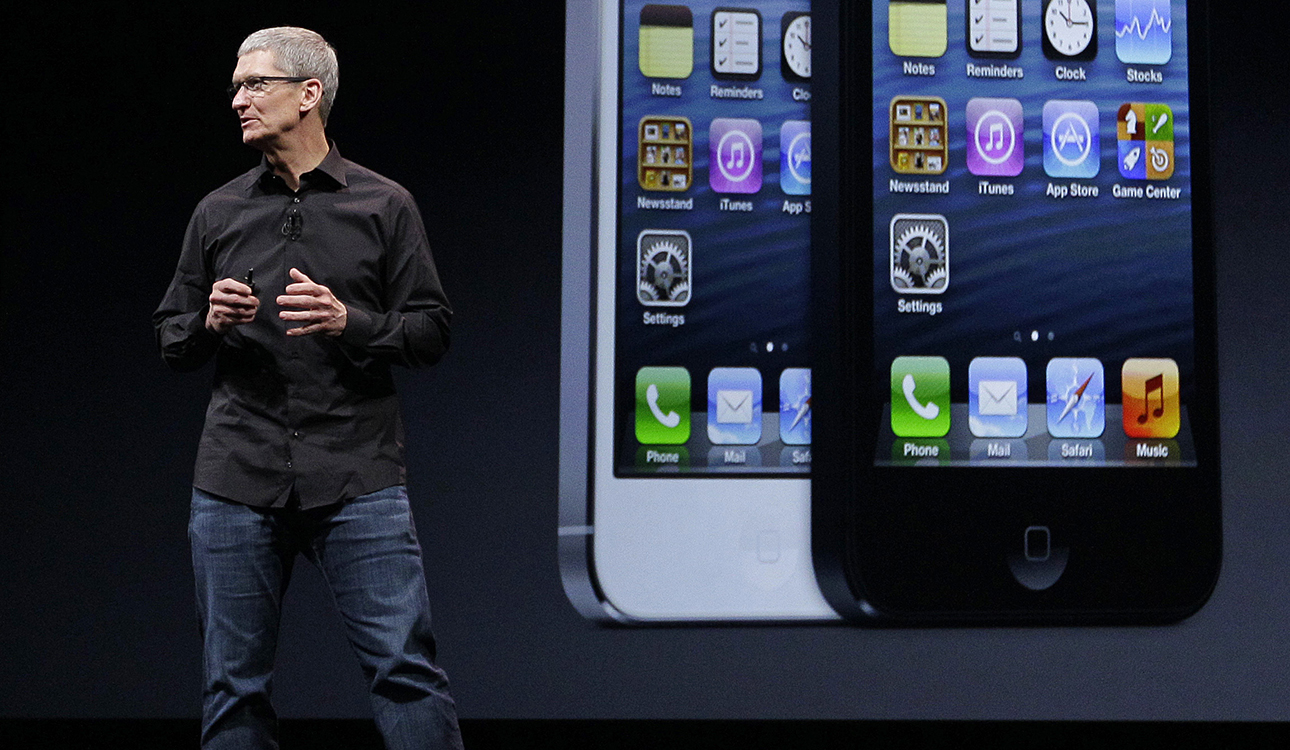
Apple CEO Tim Cook talks on stage during the introduction of the new iPhone 5 in San Francisco, Wednesday, Sept. 12, 2012. (AP Photo/Eric Risberg)
McClatchy-Tribune
Apple showed off the newest iterations of its wildly popular smartphone Wednesday morning in San Francisco, confirming that the iPhone 5 will be larger, lighter and faster while connecting to newer cellular networks.
Apple CEO Tim Cook got acolytes and analysts fired up at the Yerba Buena Center for the Arts, kicking off the unveiling of the first all-new Apple phone since the company’s co-founder and longtime CEO, Steve Jobs, died last year by telling the large crowd, “We’ve got some amazing things to show you.”
Apple marketing guru Phil Schiller followed Cook on stage for the official introduction, calling the iPhone 5 the “most beautiful device we’ve ever made.”
He immediately showed that the new iPhone will be taller than previous iterations, allowing Apple to add a fifth row of icons to the home screen.
The phone will be the thinnest and lightest iPhone yet, despite the size change, with Schiller saying the iPhone 5 is 20 percent lighter than the iPhone 4S at 112 grams.
Schiller then expounded on the technical abilities of the iPhone, which will connect with 4G, or LTE, cellular networks as well as HSPA+ and dual-band Wi-Fi.
The phone has an A6 chip that will double the speed of the CPU and graphics, which Apple demonstrated by having Rob Murray of gaming company Electronic Arts come out on stage to show off a racing game on the device.
Cook — in his Jobs-like attire of black shirt, jeans and tennis shoes — began his address by noting Apple’s success in the “post-PC era,” telling attendees that Apple has sold more iPads, the company’s tablet offering, than any tech company has sold PCs. The CEO told the excited crowd at the Yerba Buena Center for the Arts that Apple had sold 400 million devices running the company’s mobile operating system, iOS, which Cook called “amazing.”
Before the event, 9to5Mac and other blogs were able to find links prepared for news releases on Apple’s website Wednesday morning that announced the phone would be called the iPhone 5 and have LTE connectivity; other links pointed to a new version of iTunes and new iPod Touch and Nano devices.
Apple took down its online store Wednesday morning, which the company commonly does ahead of announcements of new products.
Since Cook unveiled the third-generation iPad, his first major product release, at the same spot in March, Apple’s star has only continued to expand to supernova status.
A jury last month ruled that Samsung had violated Apple’s patents for the iPhone and iPad, a potentially industry-changing verdict that analysts say could help the Cupertino, Calif., tech giant regain dominance in the smartphone market from Google’s Android operating system.
The iPhone 4S was Cook’s first product launch as Apple’s full-time CEO. The device was greeted with disappointment by many who expected a fifth-generation iPhone rather than simply an improved version of the existing product.
Critics at the time also noted Cook’s subdued manner at the launch — a mood that perhaps became more understandable the following day, when Jobs died of pancreatic cancer just six weeks after handing the company’s reins to Cook, formerly his chief operating officer.
Despite the criticism, the iPhone 4S generated blockbuster sales and record pre-orders, perhaps fueled in part by a worldwide outpouring of emotion in the wake of Jobs’ death.
The iPhone 5, by contrast, will rise or fall solely on its merits, and ISI analyst Brian Marshall has projected Apple could sell as many as 50 million of them in the December quarter alone if its supply chain can keep up.
Stephen Baker, a telecom industry analyst with NPD Group in New York, offered a minority dissent, warning that a blowout debut isn’t necessarily guaranteed for the iPhone 5. He noted that the U.S. smartphone market “appears to be an increasingly mature one” and that Apple and Android dominate it so completely there are few weaker competitors from whom Apple might steal market share.
Too, Baker pointed out, it’s been less than a year since the iPhone 4S was launched.
Apple has unveiled a new iPhone once a year, selling a reported 244 million in all — 40 percent of those during this fiscal year alone.
Android, which Google released as an open-source platform 10 months after Jobs announced the iPhone, operates some 480 million devices worldwide, according to the Mountain View, Calif., titan’s own estimates.
Entrenched players such as Dell and Hewlett-Packard have been thrown off-balance as consumers, then corporate clients began ditching their desktop and laptop computers for the increased mobility and convenience of smartphones and tablets.






